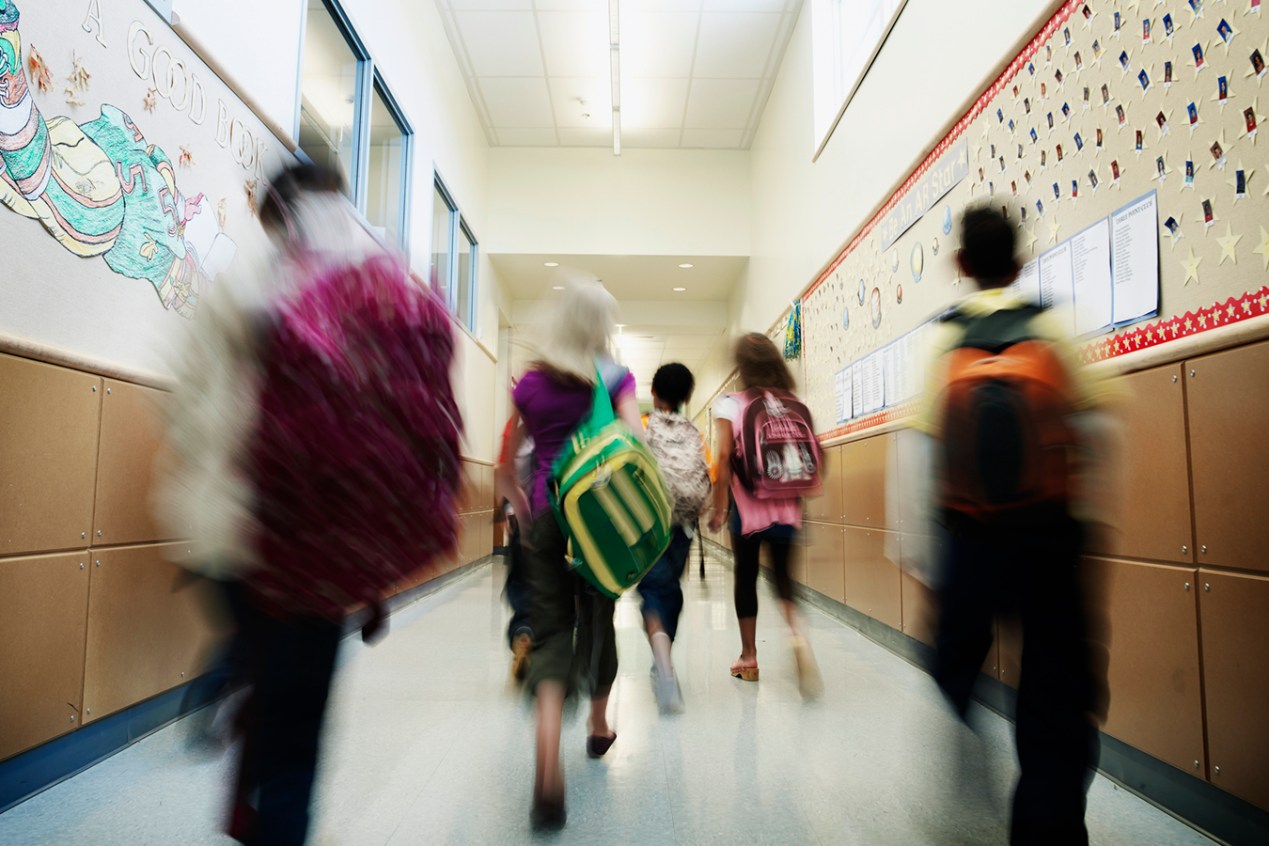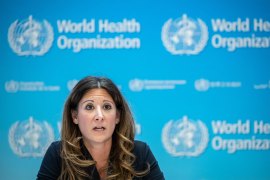As my kindergartner fumbled with his shoes, I stood at our door sifting through the mental parenting checklist newly lodged in my brain: backpack. Sweatshirt. Snacks. Sunscreen. Water bottle. KN95 mask. Vaccination card.
Jesse asked for his cloth mask, and I explained again that if he wore that one he’d need to have on a surgical mask, too, which could make it hard to run around at recess. So I did my best to twist the elastic ear loops on the KN95 into a size that would fit his cherubic face, and we headed out the door.
When we got to Will Rogers Learning Community, our school in Santa Monica, California, the entry path was split into two lines by a velvet rope. Kids and parents clustered at the rope entrance examining a paper with large print poised on a music stand. It listed the classes with covid cases, whose kids had to be tested to enter school. Those kids were shunted to the right, into the cafeteria where staff members were helping them stick swabs up their tiny noses. The rest of the kids headed into the building.
This is parenting in Southern California in the days of omicron, swimming in an ocean of angst, with currents constantly shifting direction, an awkward soup of fear, determination and gratitude for those doing the hard work of keeping schools working.
The messiness is evident in the nation’s second-largest school district, Los Angeles Unified, where roughly 520,000 kids started pouring back into schools Jan. 11 for the first time in three weeks.
“There is a lot of urgency in keeping schools open,” says Manuel Pastor, a sociologist who directs University of Southern California’s Equity Research Institute. Indeed, under a California law that took effect in July, Los Angeles can’t switch to distance learning unless there is a severe staffing shortage. Yet at the same time, the schools have strengthened safety measures that were already among the strictest in the country, upgrading masking and testing requirements.
The push-pull is essential because physical attendance is vitally important to the kids already disadvantaged because they speak other languages at home, or have parents who can’t or don’t help with their lessons, Pastor said. Yet these same kids are more likely to create risks if they bring the virus home, because their families are more likely to live in crowded homes, their parents are more likely to be essential workers, and they are more likely to have unvaccinated siblings or relatives.
“It’s kind of the worst of both possible worlds in terms of challenges in remote learning and the challenges with going back to school,” he said.
Before students could return on Jan. 11, they had to participate in baseline testing, either through a home rapid test a few days before school started — which can sometimes give false-negative results — or a PCR test at a stationary site. Some 65,000 kids tested positive before school reopened; another 85,000 or so were also absent the first day, partly, perhaps, because of parental fear of the virus.
Testing was the easiest part about getting back into school, according to many families. There were 60 locations for students to pick up free tests. The district already had the largest weekly coronavirus testing program in the nation, testing every staff member and student every week.
Children in quarantine won’t have the option to Zoom into their classrooms, however. Schools have not trained their teachers to simultaneously teach to in-room and online students. Officials say that with the district’s modified quarantine rules — which call for only students who test positive or have active symptoms of illness to stay home — those who are quarantined should be recovering, anyway, and are likely to return in a few days.
Even for those who got into school, the transition was not always smooth. On the morning schools reopened their doors, Daily Pass, the app where students upload their test results, crashed.
So instead of flashing their phones at the schoolhouse door, kids formed lines around schools and underwent a highly unscientific process to vet their state of infectiousness. Some schools went back to asking screening questions to students and parents.
Interim Superintendent Megan Reilly apologized for the Daily Pass glitches. “I knew that today was not going to be a day that we didn’t have some bumps along the road,” she said at a news conference.
Meanwhile, administrative staff members were brought in to substitute for 2,000 or so teachers (out of 25,000) who were out with covid or caring for someone infected with the virus. On Jan. 12, a school board member substituted in a classroom, and another classroom had an LAUSD architect helping out. Jenna Schwartz, an LAUSD parent who co-founded the group Parents Supporting Teachers, said the district is bringing in thousands of staffers to help out. That isn’t as bad as it sounds, she said.
“The narrative is that bus drivers will be teaching algebra, but the truth is, there are a huge amount of credentialed teachers that work in admin now,” she said. “One of the perks of having bureaucracy is that there are a huge amount of people who can fill in.”
The district’s modified quarantine policy says that if there is an exposure in a classroom, students can remain in school while asymptomatic, testing on the fifth day after a suspected exposure.
But not every school is implementing that policy, and some schools, like public charters, have leeway to make their own decisions. Paulina Jones’ 6-year-old daughter, a kindergartner at Citizens of the World Hollywood charter school, was sent home with the rest of her class for 10 days due to an exposure the first week back in school.
That’s why Jones was driving to work on Jan. 11, to a construction site where she is a manager, with her daughter in the back seat. Jones fears it’s a scenario that will keep happening, over and over. “Half the school is under quarantine right now,” she said.
Between the long winter break and this quarantine, her daughter has had only one in-person instructional day in a month. And the Zoom instruction just doesn’t work for this age group, Jones said.
“It’s extremely stressful for me to have her at work with me, but it’s more beneficial than taking 10 days off of work,” she said. “We all have to make hard decisions right now, and I have to support my family.”
There’s a weariness to the waves of illness, Jones said. “If there was an end in sight, I would take time off of work, but there’s no end in sight.”
Pastor said the situation echoes the early days of 2020, but with a noticeable difference: “There’s no talk of a shutdown. There’s just talk about managing the illness so we don’t overwhelm hospitals and health care,” he said. “There are going to be a lot of scary moments for parents.”
The words echoed in my head as I watched Jesse, fitted with his new KN95, teeter as he settled his backpack onto his small frame, then gallop off toward the right lane to enter school. As he disappeared into the school gates, I could hear him chattering to another kid: “I’m ready.”
This story was produced by KHN, which publishes California Healthline, an editorially independent service of the California Health Care Foundation.







